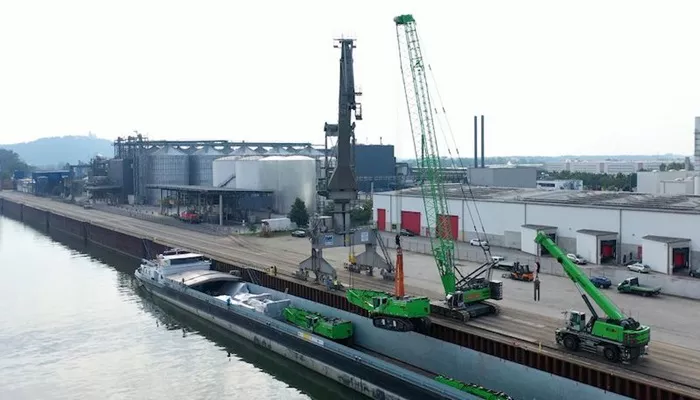SENNEBOGEN recently transported eight large machines, including its 855 and 870 models in both crawler and mobile versions, via barge. The operation, which involved machines weighing between 70 and 105 tons, required meticulous planning and innovative lifting techniques to ensure a smooth loading process.
Overcoming Logistical Challenges
Loading the heavy machines onto the barge was no small feat. Due to their size and weight, the machines could not be lifted entirely in one piece. Roland Hermann, Head of Customs and Foreign Trade Machine Shipping at SENNEBOGEN, explained, “We had to dismantle the counterweights on-site and reassemble them after loading. Additionally, the access road between the SENNEBOGEN plant and the port had to be temporarily closed to facilitate the operation.”
Tandem Lifting: Precision and Efficiency
The loading process utilized a tandem lift, where two cranes worked in unison to distribute the weight evenly. This method minimized strain on the cranes and ensured a steady, uninterrupted lift. “The first machine was loaded by 7 a.m., and by midday, seven machines were safely stowed,” Hermann reported. In total, 700 tons of machinery were successfully loaded onto the barge.
Environmental Benefits of Inland Waterway Transport
Transporting the machines by barge offers significant environmental advantages. Compared to road transport, which emits approximately 113 grams of CO2 per tonne-kilometer, inland waterway vessels emit only 34 grams. For the 800-kilometer journey, this translates to a 75% reduction in CO2 emissions, saving around 49 tons of CO2. “This is a crucial step toward making our machine shipping more sustainable. We plan to use inland waterway transport regularly in the future and are working on a comprehensive sustainability report,” Hermann added.
Collaboration with the Port of Straubing
The successful operation was made possible through close coordination with the Port of Straubing. The port played a key role in planning and implementing necessary measures, including road closures and transport permits. The city of Straubing also provided support to ensure a seamless process.
Route and Final Destination
The machines will travel from Straubing to Antwerp, where some will be loaded onto an ocean-going vessel, while others will continue to Zeebrugge. The final destination is the Port of Charleston, South Carolina, a key hub for SENNEBOGEN LLC in the United States due to its excellent infrastructure. The journey from Belgium to Charleston is expected to take two to three weeks.
Expanding the Use of Inland Waterway Transport
This successful shipment highlights the potential of inland waterway transport as a cost-effective and eco-friendly alternative to traditional methods. “Previously, we relied heavily on North Sea ports like Hamburg and Bremerhaven, but high reloading costs in Duisburg made this less viable. Inland waterway transport allows us to reduce logistics costs while supporting sustainability,” Hermann noted.
SENNEBOGEN has already conducted additional barge shipments this summer, including a SENNEBOGEN 895 E material handler bound for Israel and a 9300 E harbor crane destined for Turkey. The heaviest component shipped weighed an impressive 107 tons.
Future Plans
Moving forward, SENNEBOGEN plans to continue leveraging inland waterway transport for its heavy machinery shipments. The company will maintain its collaboration with the heavy load terminal and focus on flexible transport planning to optimize efficiency and sustainability.

